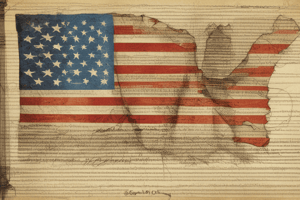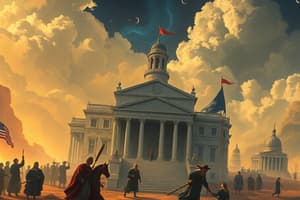Podcast
Questions and Answers
What was a significant weakness of the Articles of Confederation?
What was a significant weakness of the Articles of Confederation?
- It established a strong executive branch.
- It required unanimous consent for amendments. (correct)
- It allowed federal regulation of commerce.
- It enforced tax collection from states.
Which plan proposed a unicameral legislature and equal representation for each state?
Which plan proposed a unicameral legislature and equal representation for each state?
- The New Jersey Plan (correct)
- The Hamilton Plan
- The Virginia Plan
- The Connecticut Compromise
What was the primary concern of delegates from Rhode Island regarding a strong national government?
What was the primary concern of delegates from Rhode Island regarding a strong national government?
- Fear of significant taxation to pay off debts. (correct)
- Fear that delegates would favor larger states.
- Fear of losing representation in Congress.
- Fear of amendments restricting individual rights.
How did the 3/5's Compromise address the issue of representation in the South?
How did the 3/5's Compromise address the issue of representation in the South?
What was the role of Roger Sherman in the Constitutional Convention?
What was the role of Roger Sherman in the Constitutional Convention?
Which power was NOT granted to the federal government under the Articles of Confederation?
Which power was NOT granted to the federal government under the Articles of Confederation?
What was a major motivation behind the Constitutional Convention?
What was a major motivation behind the Constitutional Convention?
What distinguished the Virginia Plan from the New Jersey Plan?
What distinguished the Virginia Plan from the New Jersey Plan?
Flashcards
Articles of Confederation
Articles of Confederation
The first US constitution, a plan of government with only one branch: Congress. States held most power; weaknesses included lack of cooperation on defense and finances.
Constitutional Convention
Constitutional Convention
Meeting of delegates from 12 states in Philadelphia (summer 1787) to create a better government to address conflicts between states. Many worried about a strong national government.
Virginia Plan
Virginia Plan
Proposed by Edmond Randolph, favored a strong national government with three branches. Representation in the lower house was based on state population (benefiting larger states).
New Jersey Plan
New Jersey Plan
Signup and view all the flashcards
The Great Compromise
The Great Compromise
Signup and view all the flashcards
3/5's Compromise
3/5's Compromise
Signup and view all the flashcards
Powers Denied to the Federal Government (in the Articles of Confederation)
Powers Denied to the Federal Government (in the Articles of Confederation)
Signup and view all the flashcards
Powers Granted to the Federal Government (in the Articles of Confederation)
Powers Granted to the Federal Government (in the Articles of Confederation)
Signup and view all the flashcards




